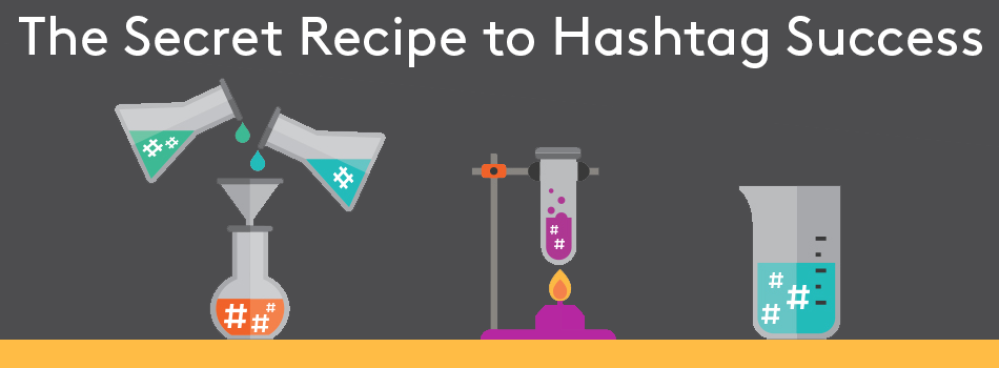The Secret Recipe to Hashtag Success
05 Jul 2017

In our recent Twitter for beginners webinar, many of our listeners had questions about how to use hashtags and best practice for using them, so we thought we’d share hashtag best practice in this blog.
What is a hashtag?
According to Twitter, ‘A hashtag—written with a # symbol—is used to index keywords or topics’’. Hashtags turn phrases and words into searchable links. You just click on the hashtag and you can see all the posts that are centred around that topic or subject. (The balance)
We’ve categorised some of the ways Marcom profs can use hashtags in their social media marketing.
Branding
Whilst we can use our brand name as our hashtag, this may not be a good idea if our brand has a long name or is already associated with other words. E.g. Meltwater also is a geological term. Choosing to hashtag a slogan or word associated with our brand is great because it can tell our brand story.
Here at Meltwater, we use the hashtag #OutsideInsight (our tagline) at events, webinars and when discussing our media monitoring brand online to encourage social buzz and increase our following. Whilst many companies currently look at inside data to form a strategy, here at Meltwater, we believe that business strategy will be increasingly shaped by data from the outside (job postings, competitor SEM data, social/ editorial footprint etc). Outside Insight is a conversation we want to be a part of, and so we associate ourselves with this theme through the hashtag.
User generated content
ASOS use #AsSeenOnMe to persuade customers to tag outfits they’ve purchased through ASOS on social media, particularly on Instagram. This particular hashtag helps increase user-generated content. In exchange for engagement, their fans are rewarded with the chance to have their photos featured on ASOS’s website and social media. It’s a win-win situation all round!

Promoting competitions
Using a hashtag can also fuel awareness for competitions. #WinItWednesday is a good place to start if we’re a smaller business- this is because the hashtag is already established and we can simply tweet our competition followed by the hashtag. Alternatively, we can also ask users to tweet a particular hashtag to win. Innocent ran a competition during the 2012 Olympics #TweetForaSeat inviting their followers to tweet who they would take to the Olympics and why.

Join conversations
Lot’s of brands also jump on trending hashtags (when appropriate). Trendjacking involves associating our brands with a hashtag or event even if there’s no real correlation. This has the potential to help our brand seem more human, increase our reach, and if done well, create a viral success. Oreo is commonly cited as pioneering this trend- during a blackout at the Superbowl in 2013 they tweeted the following. As you can see from the huge number of retweets and likes, this was very well received.

To be successful when newsjacking, it is vital we jump on the trend immediately. Once everyone knows about a story, or when it becomes yesterday’s news, we won’t have the impact we want. How can we know immediately of breaking story online? Use a media monitoring tool to discover big news stories as they begin to break- rather than when everyone knows about them.
A word of warning though- piggybacking off bad news is not okay. There are countless examples of brands who have tried to jump on hashtags about natural disasters, terrorism and deaths. A few years ago AT&T (an American mobile provider) was accused of using 9/11 to promote a phone. Whilst it may not have been their intention, it certainly led to very bad press and we should definitely avoid this.

Connecting with similar professionals
Additionally, we can join Twitter chats about our industry. These are hosted every week at a particular time – so keep that hour free to get involved and boost brand exposure, share best practice and connect with influencers. By using a media monitoring tool we can discover trends surrounding our industries/ the Twitter chat topic to help position ourselves as thought leaders, therefore improving brand credibility.
Raising awareness

Hashtags are also being used more frequently to raise awareness about important issues. For example, #movember, where men are encouraged to grow moustaches to raise awareness for men’s health issues. Using Meltwaters media monitoring tool we discovered that last November the hashtag #movember was used an astounding 142,379 times on Twitter. In contrast the year before, it was only mentioned 59,264 times. Which brings us nicely onto our next point…
Track campaign success with media monitoring

Example dashboard within our media monitoring platform
Another benefit of brands using hashtags is that we can use media monitoring to easily view the traction of a campaign. It’s pretty simple, all we have to do is pop the hashtag into the tool and we can then view analysis such as spikes in conversations, who our top posters are, trending themes mentioned alongside the hashtag, whether more males are responding to the hashtag compared to females, where in the world people are engaging with the hashtag… and so on.
Hashtags- Best Practice
- Avoid using more than 2 or 3 hashtags in a tweet. Whilst it can be tempting to try and reach as many people in one tweet, it can just look like we’re spamming.
- Check a hashtag before using it- other brands could already be using it, and we might end up accidentally promoting their products! We can use a media monitoring tool to track how popular certain hashtags are, and who’s tweeting it the most.
- If we have a brand hashtag, keep an eye on it using media monitoring to ensure it isn’t being trend jacked.
- Avoid long strings of hashtags. Not only are they annoying, but they take up crucial word count, making it difficult for people to comment around the hashtag. #MeltwaterMediaMonitoringOutsideInsight
- Keep hashtags easy to spell #pronunciation (commonly spelt pronouciation) Oxford dictionaries cite words commonly spelt wrong here:
- Hashtag on the right platforms – not every platform allows you to search using hashtags.
- Capitalise individual words to avoid potentially awkward interpretations- see this blog post on hashtag fails, for the kind of things we’re talking about.
- Have a plan in place in case hashtags do cause a crisis. Sometimes our marketing campaigns are wrongly interpreted or go viral in the worst way. Read our eBook- media intelligence for crisis comms for advice on how to deal with a PR crisis.
Check out this post to learn how to use hashtags to boost Instagram engagement (We’ve even compiled some of the regular daily hashtags)


Please login to comment.
Comments